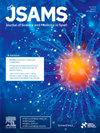康复量、心理准备和运动功能是前交叉韧带重建后成功恢复运动的重要因素:一项为期2年的随访队列研究。
IF 3
2区 医学
Q1 SPORT SCIENCES
引用次数: 0
摘要
目的:寻找前交叉韧带重建后恢复运动成功或恢复运动所需时间的影响因素。设计:队列研究。方法:对两项干预研究资料进行二次分析。参与者:我们包括成人 干预措施:在个体术后康复和再损伤预防计划结束时,自我报告和客观功能结果被量化。主要结果测量:对恢复运动成功的可能性(恢复与受伤前相同的运动类型、频率、强度和表现质量)、继发性损伤以及所有康复和训练措施进行前瞻性监测。为了确定影响因素,我们计算了性状和基线因素的Cox回归,以及包括预期时间相关因素的logistic混合模型。结果:共纳入203例受试者;104例(占总样本的51 %和全部病例的68 %)成功地恢复了体育活动。恢复运动的中位持续时间为302 天(四分位数间距为114 天)。影响因素是工作类型(蓝领vs白领:重返运动的比值比 = 0.51[95 %置信区间 = 0.29 ~ 0.90])和运动状态(精英vs非精英:比值比 = 2.28[1.03 ~ 5.03])。前瞻性地,在康复结束前较高的康复量预示着恢复运动成功:每增加一个小时的康复的优势比为1.004[1.001至1.006]。在再损伤预防结束时,功能能力,如落体起跳着陆时正常的膝关节分离距离(优势比 = 0.961[0.924至0.999])是预测的。在大多数时间点,重返运动的心理准备是可预测的:那些有信心重返运动的人在康复结束时(优势比 = 1.029[1.004至1.056])和在再次伤害预防结束时(优势比 = 1.038[1.004至1.073])更成功地重返运动。结论:前交叉韧带重建后成功恢复损伤前水平运动的最重要因素是运动量、心理准备和功能性跳跃能力。虽然这些可修改因素的影响在多层模型中是稳健的,但当包括潜在因素时,运动和工作状态的影响就消失了。本文章由计算机程序翻译,如有差异,请以英文原文为准。
Rehabilitation volume, psychological readiness, and motor function are important factors for a successful return to sport after anterior cruciate ligament reconstruction: A 2-year follow-up cohort study
Objectives
To find contributors to return to sport success or time until return to sport in individuals after an anterior cruciate ligament reconstruction.
Design
Cohort study.
Methods
Secondary analysis of the data of two intervention studies.
Participants
We included adults < 36 years of age with a tendon autograft anterior cruciate ligament reconstruction who were active in any type of sport prior to the injury and aiming to return to sport. All participants were prospectively monitored for 24 months.
Interventions
At the end of the individual post-surgery rehabilitation and re-injury prevention programmes, self-report- and objective functional outcomes were quantified.
Main outcome measures
The potential return to sport success (return to the same type of sports, frequency, intensity, and quality of performance as pre-injury), secondary injuries, and all rehabilitation and training measures were prospectively monitored. To determine the contributing factors, Cox regressions for traits and baseline factors and a logistic mixed model, which also included prospective time-dependent factors, were calculated.
Results
203 participants were included; 104 (51 % of the total sample and 68 % of the full cases) successfully returned to their sporting activity. The median duration until return to sport was 302 days (interquartile range was 114 days). Contributing factors were the type of working (blue- vs. white collar: odds ratio for return to sport = 0.51 [95 % confidence interval = 0.29 to 0.90]) and the athletic status (elite vs. non-elite: odds ratio = 2.28 [1.03 to 5.03]). Prospectively, higher rehabilitation volumes until the end of the rehabilitation were predictive for return to sport success: the odds ratio per additional hour of rehabilitation was 1.004 [1.001 to 1.006]. Functional abilities such as the normalised knee separation distance during drop jump landing (odds ratio = 0.961 [0.924 to 0.999]) were predictive at a later stage, at the end of the re-injury prevention. Psychological readiness for return to sport was predictive at most of the timepoints: those who were confident to return to sport were more successful to return to sport at the end of the rehabilitation (odds ratio = 1.029 [1.004 to 1.056]) and at the end of the re-injury prevention (odds ratio = 1.038 [1.004 to 1.073]).
Conclusions
The most important factors for a successful pre-injury-level return to sport after anterior cruciate ligament reconstruction were the exercise volume, psychological readiness and functional hop/jump abilities. Whilst the impact of these modifiable factors was robust against multilevel modelling, the impact of athletic and working status vanishes when the prospective factors are included.
求助全文
通过发布文献求助,成功后即可免费获取论文全文。
去求助
来源期刊
CiteScore
7.40
自引率
10.00%
发文量
198
审稿时长
48 days
期刊介绍:
The Journal of Science and Medicine in Sport is the official journal of Sports Medicine Australia (SMA) and is an an international refereed research publication covering all aspects of sport science and medicine.
The Journal considers for publication Original research and Review papers in the sub-disciplines relating generally to the broad sports medicine and sports science fields: sports medicine, sports injury (including injury epidemiology and injury prevention), physiotherapy, podiatry, physical activity and health, sports science, biomechanics, exercise physiology, motor control and learning, sport and exercise psychology, sports nutrition, public health (as relevant to sport and exercise), and rehabilitation and injury management. Manuscripts with an interdisciplinary perspective with specific applications to sport and exercise and its interaction with health will also be considered.

 求助内容:
求助内容: 应助结果提醒方式:
应助结果提醒方式:


